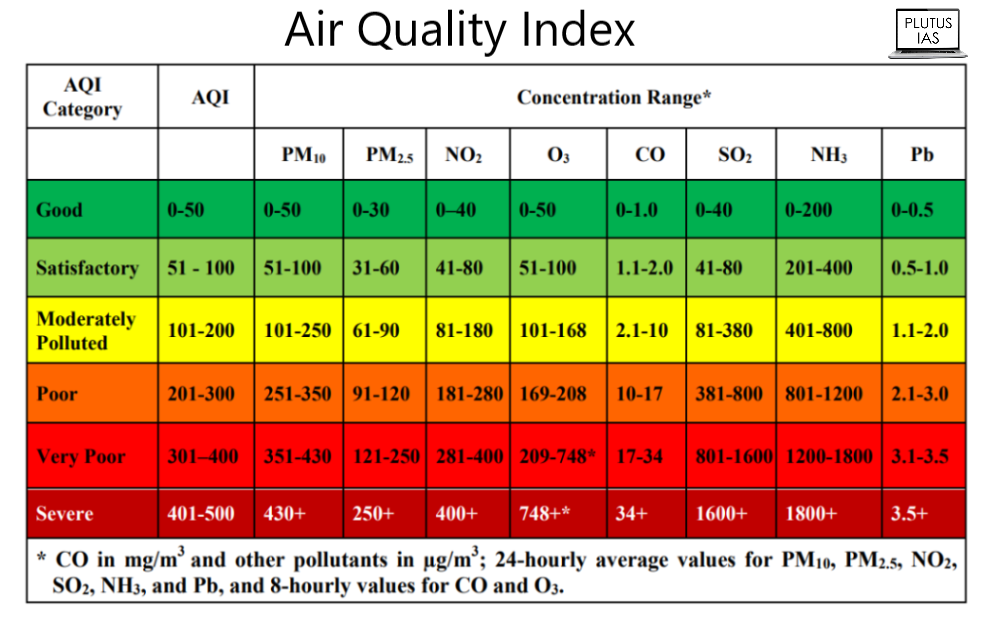25 Oct Air Quality Index
This article covers “Daily Current Affairs” and the topic details “Air Quality Index”. This topic has relevance in the “Environment and Ecology” section of the UPSC CSE exam.
For Prelims:
What is the Air Quality Index?
What is the Central Pollution Control Board?
For Mains:
GS3: Environment and Ecology
Why in the news?
Recently, the Central Pollution Control Board reported that the air quality in New Delhi has deteriorated to the “very poor” category.
Air Quality Index
- The National Air Quality Index (AQI) is a crucial tool used to communicate and assess air quality across various regions in a standardised and easily understandable manner.
- It provides a comprehensive indicator of air quality by aggregating data on multiple air pollutants into a single numerical value, along with colour-coding and specific labels to convey air quality levels to the public.
- It is managed by the Central Pollution Control Board (CPCB), Ministry of Environment, Forest and Climate Change.
- The National Air Quality Index (NAQI) derives its calculations from live data collected at various monitoring stations throughout India.
- The AQI encompass eight pollutants:
- Sulphur Dioxide (SO2)
- Nitrogen Dioxide (NO2)
- Particulate Matter (PM10)
- Particulate Matter (PM2.5)
- Carbon Monoxide (CO)
- Ozone (O3)
- Ammonia (NH3)
- Lead (Pb)
- The resulting AQI value is classified into six levels: Good, Satisfactory, Moderately polluted, Poor, Very Poor, and Severe.
- Each category corresponds to a specific colour code to enhance comprehension and is associated with well-defined health implications.

About Central Pollution Control Board
-
- The Central Pollution Control Board (CPCB), a statutory organisation, was constituted in September 1974 under the Water (Prevention and Control of Pollution) Act 1974.
- Further, CPCB was entrusted with the powers and functions under the Air (Prevention and Control of Pollution) Act, 1981.
- It serves as a field agency and provides technical services to the Ministry of Environment and Forests under the Environment (Protection) Act, 1986 provisions.
- Principal Functions of the CPCB
-
- To promote the cleanliness of streams and wells in different areas of the States by prevention, control and abatement of water pollution
- To improve air quality and to prevent, control or abate air pollution in the country.
Sources: Air quality worsens, may stay ‘very poor’ for next three days – The Hindu
Download plutus ias current affairs eng med 25th Oct 2023
Q1. With reference to the Air Quality Index, consider the following statements:
- AQI includes six categories for the quality of air.
- It is managed by the Indian Institute of Tropical Meteorology (IITM), Pune and is operationalised by the India Meteorological Department (IMD).
- It was introduced by the Ministry of Earth Sciences (MoES)
Which of the statements given above is/are NOT correct?
(a) 1 and 2 only
(b) 2 and 3 only
(c) 3 only
(d) None
Q2. Consider the following:
- Sulphur Dioxide (SO2)
- Nitrogen Dioxide (NO2)
- Particulate Matter (PM1.0)
- Particulate Matter (PM2.5)
- Carbon Monoxide (CO)
- Carbon Dioxide (CO2)
How many of the abovementioned pollutants are monitored under Air Quality Index?
(a) Only two
(b) Only three
(c) Only four
(d) Only five
Q3. Discuss the significance of the Air Quality Index (AQI) and the role of the Central Pollution Control Board in managing air quality and pollution control in the country.




No Comments